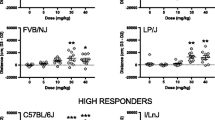Abstract
While low doses of cocaine have been shown to decrease locomotor activity, and moderate doses produce marked increases in locomotor activity, high doses commonly produce seizures and, eventually, death. However, the biological mechanisms associated with cocaine-related death, as well as the contribution of seizure activity to death, are poorly understood. This study examined the effects of a broad range of cocaine doses on acute occurrence of seizures and death in LS/Ibg (LS) and SS/Ibg (SS) mice. Large differences in sensitivity to cocaine-induced seizures were seen, with ED50 values being 41.7 and 80.9 mg/kg for the SS and LS mice, respectively. Conversely, no significant differences in cocaine LD50 values were found, being 100.7 and 107.2 mg/kg for the SS and LS mice, respectively. That these lines of mice differ substantially in convulsant responses to cocaine, but show no difference in lethal response to this drug, supports the conclusion that cocaine causes death by mechanisms distinct from those which contribute to seizures. The distinction between cocaine-induced seizures and lethality in these lines may prove useful in elucidating the underlying mechanisms of these traits. In a subsequent study, the incidence of seizures in F1 and F2 generation mice from hybrid matings of LS and SS parents was not consistent with a single gene hypothesis, suggesting that multiple genes and receptors mediate seizurgenic responses to cocaine. Further, albino mice from the F2 generation did not show a significantly different incidence of seizures than non-albino mice, indicating that of the genes contributing to seizures following cocaine, none appear to be closely associated with the albino locus on mouse chromosome seven.
Similar content being viewed by others
References
Baker RC, Smolen A, Deitrich RA (1985) Relationship between acute ethanol responses in long-sleep and short-sleep mice. Alcohol Clin Exp Res 9:201
Bose J (1902) Cocaine intoxication and its demoralizing effects. Br Med J 2:1020–1022
Collins AC, Lebsack ME, Yeager TN (1976) Mechanisms that underlie sex-linked and genotypically determined differences in the depressant actions of alcohol. Ann NY Acad Sci 273:303–316
Cooper JR, Bloom FE, Roth RH (1982) The biochemical basis of neuropharmacology, 4th Edition. Oxford Press, New York
de Fiebre CM, Ruth JR, Collins AC (1989) Differential sensitivity to high doses of cocaine in long-sleep and short-sleep mice. Pharmacol Biochem Behav 34:887–893
DeFries JC (1989) LSXSS recombinant inbred strains of mice: initial characterization. Alcohol Clin Exp Res 13:196–200
Dibner MD, Zahniser NR, Wolfe BB, Rabin RA, Molinoff PB (1980) Brain neurotransmitter receptor systems in mice genetically selected for differences in sensitivity to ethanol. Pharmacol Biochem Behav 12:509–513
Dudek BC, Fanelli RJ (1980) Effects of gamma-butyrolactone, amphetamine and haloperidol in mice differing in sensitivity to alcohol. Psychopharmacology 68:89–97
Dudek BC, Abbott ME, Garg A, Phillips TJ (1984) Apomorphine effects on behavioral response to ethanol in mice selectively bred for differential sensitivity to ethanol. Pharmacol Biochem Behav 20:91–94
George FR (1989) Cocaine produces low dose locomotor depressant effects in mice. Psychopharmacology 99:147–150
George FR (1991) Cocaine-toxity: genetic differences in cocaine-induced lethality in rats. Pharmacol Biochem Behav (in press)
George FR, Collins AC (1985) Ethanol's behavioral effects may be partly due to increases in brain prostaglandin production Alcohol Clin Exp Res 9:143–146
George FR, Goldberg SR (1988) Genetic factors in response to cocaine. In: Clouet D, Asghar K, Brown R (eds) Mechanisms of cocaine abuse and toxicity. NIDA Research Monograph Series, vol 88. US Department of Health and Human Services, Rockville, MD, pp 239–249
George FR, Goldberg SR (1989) Genetic approaches to the analysis of addiction processes. TIPS 10:68–74
George FR, Ritz MC (1990) Cocaine produces locomotor stimulation in SS but not LS mice: relationship to dopaminergic function. Psychopharmacology 101:18–22
George FR, Porrino LJ, Ritz MC, Goldberg SR (1991) Inbred rat strain comparisons indicate different sites of action for cocaine and amphetamine locomotor stimulant effects. Psychopharmacology (in press)
Goldstein DB, Kakihana R (1976) Alcohol withdrawal reactions in mouse strains selectively bred for long or short sleep time. Life Sci 17:981–986
Hoffer B, Siggins G, Bloom F (1969) Prostaglandins E1 and E2 antagonize norepinephrine effects on cerebellar purkinje cells: a microelectrophoretic study. Science 166:1418–1420
Karch SB (1989) The history of cocaine toxicity. Hum Pathol 20:1037–1039
Marley RJ, Stinchcomb A, Wehner JM (1988) Further characterization of benzodiazepine receptor differences in long-sleep and short-sleep mice. Life Sci 43:1223–1231
McClearn GE, Kakihana R (1981) Selective breeding for ethanol sensitivity: short-sleep and long-sleep mice. In: McClearn GE, Dietrich RA, Erwin VG (eds) Development of animal models as pharmacogenetic tools. Research Monograph No. 6. USDHHS-NIAAA, Washington, pp 147–159
McIntyre TD, Trullas R, Skolnick P (1988) Differences in the biophysical properties of the benzodiazepine/-aminobutyric acid receptor chloride channel complex in the long-sleep and short-sleep mouse lines. J Neurochem 51:642–647
Phillips TJ, Dudek BC (1983) Bicuculline-induced seizures in mice which differ in sensitivity to ethanol. Soc Neurosci Abstr 9:1240
Ritchie JM, Greene NM (1985) Local anesthetics. In: Gilman AG, Goodman LS, Rall TW, Murad F (eds) The pharmacological basis of therapeutics, 7th edn. McMillan, New York, pp 302–321
Ritz MC, Lamb RJ, Goldberg SR, Kuhar MJ (1987) Cocaine receptors on dopamine transporters are related to self-administration of cocaine. Science 237:1219–1223
Ruth JA, Ullman EA, Collins AC (1988) An analysis of cocaine effects on locomotor activities and heart rate in four inbred mouse strains. Pharmacol Biochem Behav 29:157–162
Shuster L, Yu G, Bates A (1977) Sensitization to cocaine stimulation in mice. Psychopharmacology 52:185–190
Starke K (1977) Regulation of noradrenaline release by presynaptic receptor systems. Rev Physiol Biochem Pharmacol 77:1–123
Steinberg D (1988) PROBIT: a supplementary module for SYSTAT and SYSGRAPH. Evanston, IL:SYSTAT
Wilkinson L (1987) SYSTAT: the system for statistics. Macintosh version 3.2. Evanston, IL:SYSTAT
Author information
Authors and Affiliations
Rights and permissions
About this article
Cite this article
George, F.R. Cocaine toxicity: genetic evidence suggests different mechanisms for cocaine-induced seizures and lethality. Psychopharmacology 104, 307–311 (1991). https://doi.org/10.1007/BF02246028
Received:
Revised:
Issue Date:
DOI: https://doi.org/10.1007/BF02246028




